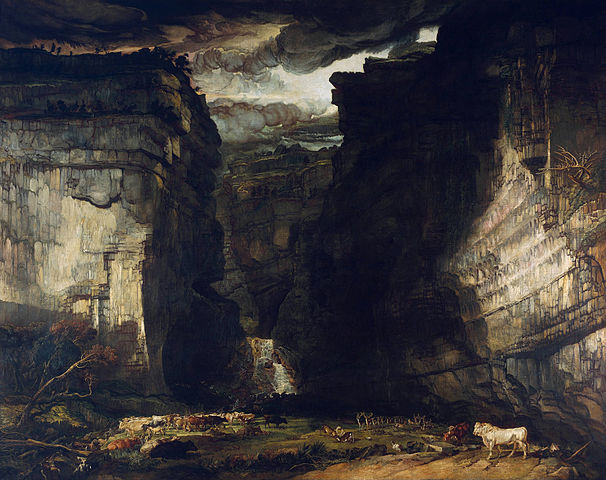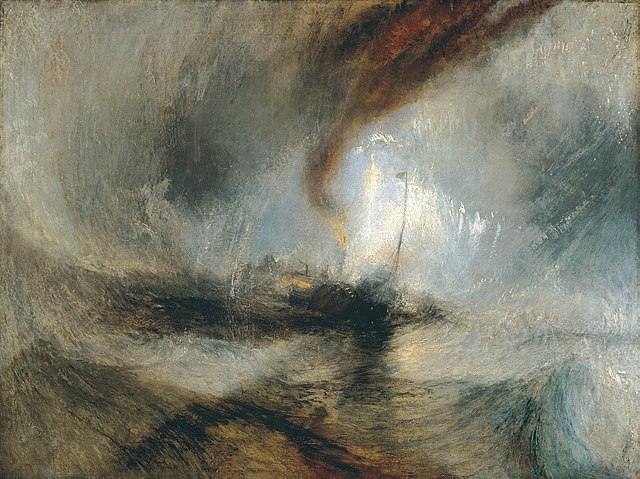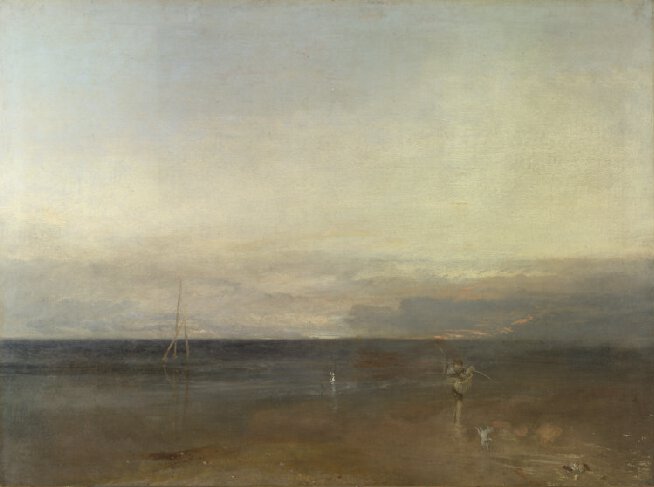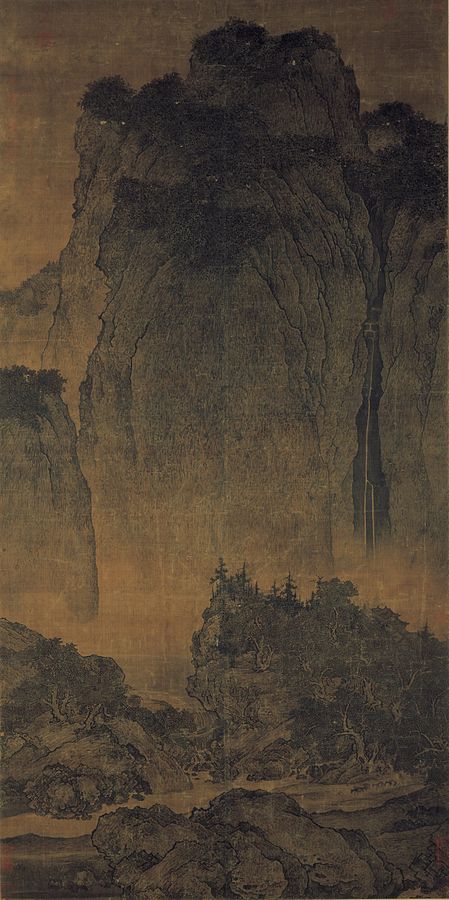The dictionary defines “sublime” thus:
1. elevated or lofty in thought, language, etc.:
Paradise Lost is sublime poetry.
2. impressing the mind with a sense of grandeur or power; inspiring awe, veneration, etc.:
Switzerland has sublime scenery.
The first type of sublime is often found in antiquity, while the second is characteristic of the Romantic period. The Romantic period sought the sublime by emphasizing the rough, awesome, frightening aspects of nature. Around 1950, painters in the so-called New York School developed an Abstract Sublime. By exploring the topic of the sublime, we can get a better understanding of ancient art, Romantic art, and modern art.
Longinus, who wrote On the Sublime, equated the sublime with large ideas and strong emotions. He said that the sublime is the product of a great soul, and it speaks to the great soul within each of us. Longinus wrote in Greek, and probably lived around 50 AD, but nothing is known about him, and scholars have long debated who really wrote On the Sublime.
In 1739, an English scholar named William Smith translated On the Sublime into English, and it aroused keen interest among English intellectuals. One of the readers of Smith’s translation was the young Edmund Burke; while still a teenager, Burke wrote a treatise on The Sublime and Beautiful (1757).1 Burke’s book influenced German writers on aesthetics — Lessing, Schiller, Kant, etc. So Longinus’ book has had considerable impact on aesthetic theories — perhaps a greater impact than any work other than Aristotle’s Poetics.
Longinus distinguishes the sublime from the beautiful. Helen’s beauty launched 1,000 ships, but it didn’t make her sublime. The sublime often causes bewilderment, wonder, fear. As Kant said, beauty is a matter of form, and form has boundaries, but the sublime is formless and boundless.2
An example of the boundless sublime is the universe itself. In the following passage, Poe discusses how planets revolve around the sun, and the whole solar system revolves around something larger:
| We go on to conceive these clusters themselves, again, as revolving about one still more august sphere; this latter, still again, with its encircling clusters, as but one of the yet more magnificent series of agglomerations, gyrating about yet another orb central to them — some orb still more unspeakably sublime — some orb, let us rather say, of infinite sublimity.3 |
Stendhal said that beauty is a promise of happiness, but the sublime doesn’t promise happiness, it provokes awe and wonder. When the astronomer tells us about supernovas, black holes, and the Big Bang, he isn’t promising happiness, he’s provoking awe, wonder, and perhaps fear.
According to Burke, “Greatness of dimension is a powerful cause of the sublime.” Certainly the universe has “greatness of dimension.” Another cause of the sublime, according to Burke, is obscurity. What’s more obscure than the universe? We never completely fathom its dark reaches, we never find its remote boundaries.4
I’ve wandered far from Longinus. Forgive me, I’m dealing with a topic that’s formless and boundless, so I should be excused for writing a formless essay.
One question that Longinus deals with is, Why has oratory declined? Why has oratory become merely an exercise in style? This topic was much discussed in the first century AD. Petronius blamed the schools of rhetoric for the decline of oratory. Tacitus blamed the rise of the principate, and the fall of political freedom. Longinus argues that the sublime requires a great soul, a high spirit, and this is undermined by despotism, and by moral decay. As Mencius said that only a good man can write good prose, so Longinus argued that only one who possesses “moral excellence” can create great literature, can attain the sublime.
Longinus is concerned with literature, not visual art or nature. He tries to describe “the essentials of a noble and impressive style.” He realizes that one can’t achieve such a style by following certain rules, by using certain techniques. The sublime is only achieved by a great soul moved by large ideas and strong passions. Indeed, the sublime often breaks the rules, and often has a faulty technique. Longinus “admires the boldness of the Genius, which always succeeds in reaching the zenith, even if at the expense of forgivable lapses in style.”5 Longinus admires the writer who takes risks, risks that are “bold, lawless, and original”; he admires works that have a “brave disorder.”
On the Sublime has often been ignored by academics because it focuses on the spirit of literature, it lacks “practical rules of a teachable kind.”6
Longinus notes that a characteristic of the sublime is simplicity — a lack of sophistication, an absence of technique. Longinus quotes the Bible, “And God said, Let there be light: and there was light.” (Since it’s rare for a writer from this period to quote the Bible, some scholars have speculated that Longinus was Jewish.)
The sublime is the product of a great soul, and it speaks to the great soul within each of us, and creates a bond between writer and reader. The sublime can also mold us, it can foster the great soul within us, it has educational power. Thus, On the Sublime deals with ethics as well as aesthetics.
In the presence of the sublime, we forget ourselves, we lay aside our reason, we’re transported by a kind of ecstasy, we’re reduced to silent wonder. The sublime elevates us. As Schiller wrote,
| Who can tell how many luminous ideas, how many heroic resolutions, which never would have been conceived in the dark study of the imprisoned men of science, nor in the salons where the people of society elbow each other, have been inspired on a sudden during a walk, only by the contact and generous struggle of the soul with the spirit of nature?7 |
the Abstract Sublime
One of the characteristics of the Romantic period is its preference for the sublime over the beautiful. Surely one cause of this fondness for the sublime is the impact of Longinus, Burke, etc. Another cause is the rejection of the rational-mechanical universe of the Enlightenment, a preference for mystical ecstasy over rational calculation. A third cause may be the gradual, spontaneous evolution of the appreciation of nature; what had been unattractive, even frightening, became aesthetically pleasing; mountain gloom became mountain glory.8
Here’s a painting made about 1810 by English painter James Ward:

Gordale Scar
It’s likely that Ward had read Burke, or at least heard his ideas discussed. We recall that, according to Burke, “Greatness of dimension is a powerful cause of the sublime.” Ward emphasizes the vastness of the cliff by juxtaposing it with tiny figures of cattle.
Burke also said that obscurity is a cause of the sublime: “In painting [wrote Burke], a judicious obscurity in some things contributes to the effect of the picture.” Ward achieves this “judicious obscurity” by depicting Gordale Scar on a dark day, and by filling his canvas with dark shadows.
Poe complained that immature poets try to attain sublimity by obscurity of expression, “confounding obscurity of expression with the expression of obscurity.”9 Milton, on the other hand, attains sublimity with language that’s grand, simple, clear; Milton’s obscurity is in his things, not his words, in his images, not his language. Theorists like Burke and Coleridge regarded Milton as the master of the sublime. Burke praises the “judicious obscurity” of Milton’s description of Death:
The other shape,
If shape it might be called that shape had none
Distinguishable in member, joint, or limb,
Or substance might be called that shadow seemed,
For each seemed either; black it stood as Night,
Fierce as ten Furies, terrible as Hell,
And shook a dreadful Dart; what seemed his head
The likeness of a Kingly Crown had on.
Poe was familiar with the aesthetic theories of Burke, Schiller, etc. Poe’s interest in the sublime is evident in his critical essays and also in his imaginative works. When Poe writes a story about a boat being sucked into a giant whirlpool, he’s depicting the awesome, frightening aspects of nature, he’s striving for the sublime.10 Poe’s interest in the sublime is characteristic of his period, the Romantic period.
Poe’s treatise on the universe, Eureka, begins by asking, “What terms shall I find sufficiently simple in their sublimity — sufficiently sublime in their simplicity — for the mere enunciation of my theme?” Notice that Poe strives for the sublime, he searches for the right “terms,” whereas primitive writers, like the author of Beowulf or The Book of Genesis, reach the sublime without striving, reach the sublime naturally and effortlessly.
Let’s look at another painting from the Romantic era, another painting in which the sky is obscured (as in Gordale Scar) by heavy weather. This painting is by Turner, and is called Snowstorm: Steamboat off a Harbor’s Mouth.

Some critics feel that Turner’s pursuit of the sublime is exaggerated, that Turner was carried away by his fondness for the sublime. One might compare Turner’s Snowstorm to a painting by Jackson Pollock; Pollock has been viewed as a representative of the Abstract Sublime. Like Turner, Pollock depicts “superhuman turbulence” and a “boundless web of inexhaustible energy.”11 This isn’t beauty, this isn’t a “promise of happiness.”

detail from Alchemy (1947), by Jackson Pollock
If Turner was the leading representative of the Romantic Sublime in England, Caspar David Friedrich was its leading representative in Germany. Friedrich was born in Germany in 1774, one year before Turner. Friedrich often depicts a solitary person contemplating nature, as in Monk by the Sea (1810):

Mark Rothko, a representative of the Abstract Sublime, admired Friedrich. We can view landscapes like Monk by the Sea as fields of color, similar to a Rothko painting. “In the abstract language of Rothko,” wrote Robert Rosenblum, “we ourselves are the monk before the sea, standing silently and contemplatively before these huge and soundless pictures as if we were looking at a sunset or a moonlit night.” Consider this color-field painting by Rothko:

By calling this painting “Light Earth Over Blue,” Rothko may be inviting a comparison with landscape. Here’s a landscape by Turner that might be compared to a color-field painting:

Evening Star (1830)
One of Friedrich’s best-known paintings is his Wanderer above the Sea of Fog, in which a solitary wanderer overlooks a rough, rocky, steep landscape that’s shrouded in fog:

A century before Friedrich painted Wanderer above the Sea of Fog, the Chinese painter Shitao depicted a wanderer overlooking a rough, rocky, steep landscape that’s shrouded in fog:

Waterfall on Mt. Lu
Chinese landscapes often include a solitary person, but the person isn’t turned directly away from the viewer, as in Friedrich’s Wanderer. And the person in Chinese landscapes isn’t as large, relative to the landscape, as the person in Friedrich’s Wanderer.
The Chinese developed an appreciation of the sublime, an appreciation of “mountain glory,” before Europeans did. Here’s a Chinese landscape from about 1000 AD; you can just barely make out a group of travelers in the bottom right, beneath the towering mountain.

Fan Kuan
Traveling Among Streams and Mountains
This Chinese landscape reminds us of the huge, steep cliff in James Ward’s Gordale Scar.
In the painting below, Friedrich depicts a rough, rocky, steep scene. No place for a picnic here, so you know it’s sublime, not beautiful.

American painters were also familiar with Burke, and also strove for the sublime. Here’s a landscape by Thomas Cole, painted in 1827, with the steep cliffs that we saw in Friedrich:

Scene from Last of the Mohicans
The recent riot in Charlottesville began with a dispute over whether to remove a statue of Robert E. Lee. There are now “statue disputes” all over the South. Statue disputes occur in other countries, too; in Russia, there were disputes over Stalin statues, and China will probably have disputes over Marx statues.
Trump criticized the effort to remove the Lee statue, asking “Who’s next? Will statues of Washington and Jefferson be removed? They owned slaves.” The historian Jon Meacham responded to Trump:
| The answer to Mr. Trump’s question begins with a straightforward test: Was the person to whom a monument is erected on public property devoted to the American experiment in liberty and self-government? Washington and Jefferson and Andrew Jackson were. Each owned slaves; each was largely a creature of his time and place on matters of race. Yet each also believed in the transcendent significance of the nation, and each was committed to the journey toward “a more perfect Union.” |
Meacham’s argument overlooks the fact that Washington, Jefferson, and Jackson weren’t faced with the choice that Lee was faced with. Lee felt that federal troops were invading Virginia, his home state, and were bent on destroying states rights. The Constitution didn’t explicitly say whether states had the power to nullify federal laws, or the power to secede from the Union. Southerners viewed the complex issue of states rights differently from Northerners.
Grant said that no army had ever fought for a worse cause than the Confederate Army. But who can doubt that, if Grant had been born in Virginia or Alabama, he would have fought for the Confederacy, he would have espoused Confederate arguments about states rights, and he would have believed that Confederate states were fighting, not for slavery, but for their rights?
Lee is one of the heroes of American history, but he was caught in a tragic situation, a tragic conflict. He had no good option, and he hesitated a long time before deciding to throw in his lot with the Confederacy.
But even if we regard Lee as a hero, it doesn’t follow that statues of Lee should stay permanently. Many Confederate statues were probably erected, not only out of respect for Confederate heroes, but also as a gesture of defiance toward the North. Many Confederate statues probably shouldn’t have been erected in the first place. On the other hand, should an angry mob with a strong rope be allowed to remove statues?
The Charlottesville riot indicates the fraying of the social fabric, the polarization of American politics. Both Left and Right talk occasionally of separation/secession. Many of the right-wing marchers in Charlottesville were carrying guns, so the next such riot could become a street battle.
Trump has made a policy of rudeness, but Democrats aren’t far behind. One Democrat, California Senator Kamala Harris, has adopted the slogan “Courage Not Courtesy.”
I recently watched Bill Kristol’s “Conversation With Charles Murray,” in which Murray discusses the idea of a Universal Basic Income. This idea has champions on both the Right and the Left. Murray’s plan calls for the federal government to pay every American citizen about $1,000/month once he reaches age 21. This Universal Basic Income would replace welfare and other social programs. Unlike welfare, it wouldn’t be means-tested, so it wouldn’t require a large bureaucracy to administer. Unlike welfare, the Income wouldn’t rise if you had children, so it wouldn’t incentivize people to have children. The Income could be withdrawn for various reasons — for example, it could be withdrawn if one owed alimony or child-support. Murray forgot to mention (has anybody remembered to mention?) that it would be useful for the struggling artist/writer; Thoreau wouldn’t need his bean field if he had a Universal Basic Income.
Update November 2017: According to the New York Times, the “centerpiece proposal” of Italy’s Five Star Movement is “a universal guaranteed income.” The idea is being tried in Finland, Kenya, etc.
For more on Murray, click here.
© L. James Hammond 2017
feedback
visit Phlit home page
make a donation via PayPal
| Footnotes | |
| 1. | I suspect that Burke would never have written about the sublime, or about aesthetics, if it weren’t for the buzz created by Smith’s translation of Longinus. back |
| 2. | See Robert Rosenblum’s essay on the Abstract Sublime. back |
| 3. | This passage is from Poe’s treatise Eureka. I found the passage in an essay called “Poe and the Sublime: His Two Short Sea Tales in the Context of an Aesthetic Tradition.” back |
| 4. | The modern painters who are classified as Abstract Sublime (Jackson Pollock, Mark Rothko, etc.) certainly achieve obscurity. As for “greatness of dimension,” these painters have a preference for large canvases. back |
| 5. | Wikipedia. The sublime can be found in any branch of culture. The film director Werner Herzog called Longinus a good friend, and gave a talk called “On the Absolute, the Sublime and Ecstatic Truth.” When I read history, I often find the sublime — especially in primary sources, where the author has strong passions. The novelist can also attain the sublime. Melville often attains the sublime in Moby Dick, as in this passage: “The rushing Pequod, freighted with savages, and laden with fire, and burning a corpse, and plunging into that blackness of darkness, seemed the material counterpart of her monomaniac commander’s soul.” back |
| 6. | Wikipedia back |
| 7. | Quoted in “Poe and the Sublime,” by Kent Ljungquist back |
| 8. | See Marjorie Hope Nicolson’s Mountain Gloom and Mountain Glory: The Development of the Aesthetics of the Infinite. See also Robert Macfarlane’s Mountains of the Mind. back |
| 9. | See “Poe and the Sublime” back |
| 10. | See Poe’s “Descent Into the Maelstrom” and his “Ms. Found in a Bottle.” Poe was fond of math, and this fondness is apparent in “Descent into the Maelstrom,” “The Gold-Bug,” etc.
Another Poe story that I read recently is “The Oval Portrait,” which critics have compared with Hawthorne’s story “The Birthmark.” Poe’s story deals with an obsessed artist, Hawthorne’s with an obsessed scientist.
Coleridge thought that the chief characteristic of our civilization was its feeling for the sublime: |
| 11. | These are Robert Rosenblum’s remarks on Pollock. back |